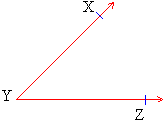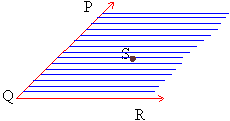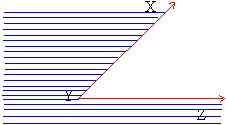1.3 Rays and Angles
A ray has one end point and extends in the other direction upto infinity. It is represented by naming the end point and any other point on the ray with the symbol® (figure 1.10 ).
 
Figure 1.10
J is the end point of a ray and K is a point on it. This ray is represented as  . A ray can extend in any one direction only. . A ray can extend in any one direction only.
Two rays going in different directions, but having a common end point, form an angle. The common end point is called the vertex of the angle and the rays are called its sides or arms. An angle is represented by the symbol Ð and named, using either both the rays or just the vertex (figure 1.11).

Figure 1.11
Figure 1.11 represents Ð XYZ or Ð Y.
Interior and Exterior of an angle : The interior of
Ð PQR is the shaded region in figure
1.12. S is a point in the interior of ÐQ
because it lies on the R- side of ray PQ and the P - side of ray
QR. The set of all such points is called the interior of ÐPQR.

Figure 1.12
In figure 1.13 the shaded region shows the exterior of Ð XYZ. The exterior of an angle is defined as the set of points in the plane of a given angle which are neither on the sides of the angle nor in its interior.

Figure 1.13
|